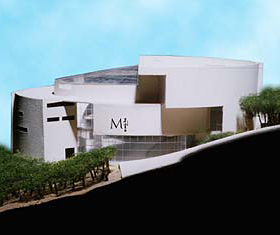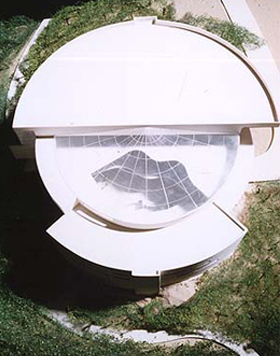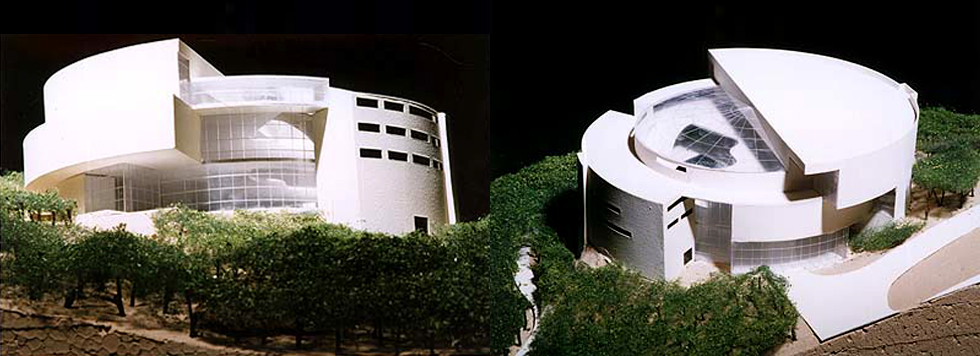Search

ACADEMIC PROFILE
Master Faculty of Architecture and Urbanism of the University of São Paulo since 1998 under the guidance of Professor Joaquim Guedes Sobrinho Area Project, with the option in research and design a museum for the city of São Paulo, the MiN - Museum Installation, with a dissertation titled: Architecture of Museums - The World Production Architectural Showcase.
A DISSERTATION
The project can be seen below is derived from an exhaustive and difficult search, because, in spite of my limited ability to collect, BOOK REPORT and text transcript, there was nothing on the subject at the time the survey was drawn up. For both always welcome foreign trips were of great value for the visitation of the examples' in situ ', besides the purchase of new material that was all translated and compiled, added that' my own observations contituiram the scope of the dissertation. This revealed my real desire to do a dissertation yet unheard more particularly true in the sense that all the words contained there were mine. Everything that is written belongs to my universe of knowledge, discarding the repetition of texts or shuffled footer copies of books. It is a personal work that shines through all that desire and hope of a good and correct architecture, befitting its destination, form and function. It was not intended at any time fix a museum paradigm but rather to verify the possibility of ideality of a museum to his program, his subject and his character previously proposed.
The main objective of this thesis was to propose a new museum for the city of São Paulo under current standards and directed to the 21st century. For both elaborated a project for a museum focusing on contemporary arts facilities at the level of preliminary design and Alfredo Volpi park located in the Bosque do Morumbi. To support this proposal / project was made a research on the evolution of the Architecture Museum in the world, their participation in technological progress, new concepts and standards and especially the changes occurred with the introduction of the New Museology and its causes. This research was divided into four parts:
A panel of museum architecture evolution preceding the Boom Museum 'occurred in the last quarter century.
A study of museum-visitor relationship, developing a program and the structure of the body of a museum.
The analysis of fifteen projects selected and divided into five areas - Restructuring, Attachments and Upgrades, Projects Completed, Future Museums and Galleries.
A conclusion on this evolution museum, its causes and effects and data relevant to the preparation of a museum today.
NEW MUSEOLOGY
From the classical Greek definition for the word museum: "Mouseion - Temple of the Muses" at the International Council of Museums (ICOM): "A museum is a permanent institution, nonprofit organization, the service of society and its development, and open to
public ... "a lot has changed. And it would be different with this institution as celebrated and that this past quarter-century served as the backdrop for technological innovations and aesthetics of architecture. Concepts such as traveling exhibitions, shops, bookstores, restaurants and even boutiques on the premises of the museum entrance fee and rental spaces inside the museum, certainly flee from the above definition. Of course, by numerous financial crises and the increasing difficulty of museums rely on government subsidy, state or municipal eventually forcing them to leave for new lines of revenue. It began with the entrance fee, then with the advent of American museologoia, opening bookstores, cafes, restaurants to shops and brand names such as parades Carroussel see today in the Louvre in Paris. Yes, the museums need money to survive and their maintenance is costly. Unfortunately, despite all these new alternatives, even émuito bit because according to the American Association of Museums, the entire profit of bookstores, shops and so on ... covers only 10% of total expenditures for maintenance, payroll, accounts and ancillary services. When not in itself also from exposure to those not sponsored.
THE ROLE OF MUSEUMS CHANGED!
Until 1970 the museums were distinguished by issues such as Anthropology, Fine Arts / Modern Art / Contemporary Art, Archaeology, Natural History / Social Science / Technology. Now we are faced with a flurry of new issues, is called the 'Specification of the Museum Themes' that generated its multiplication. Today we find the Wood Museum (Japan), the Shoe Museum - Bata Shoe (Canada), Museum of Power (Switzerland), Museum of the Vikings (Roskilde / Denmark), the Fashion Museum (France), and so on ... There are many, but the more interesting than they have in common is that the vast majority comes from our society and its evolution within other subjects, ie, humanity is always in question and its history. This allows us to conclude that discarding the banalizaçnao art and exhibition material, the multiplication of issues came to adding new parameters and knowledge of our society.
The Boom Museum 'occurred in the last quarter century has brought with it new definitions beyond aesthetic and museological - New Museology, a close race between architects, who demonstrated that the Architecture Museum was the great vedette of this end of millennium, as well as palaces and factories once were. Every great architect without exception, drafted a museum, Mies Van Der Rohe, Le Corbusier, Louis Kahn, Frank Lloyd Wright (the happiest of them, with the Guggenheim Museum in New York), Alvar Aalto, Renzo Piano and Richard Rogers, Gae Aulenti I. M. Pei, James Stirling, Norman Foster, Robert Venturi, Richard Meier, Frank O. Gehry, Arata Isozaki, Hans Hollein, Kisho Kurokawa, Jean Nouvel, Rem Koolhaas, Aldo Rossi, Mario Botta. You can not say, however, that the excess generated discrepancies projects that can ascertain, nor the war of 'egos'. But we can certainly say that the plurality of ideas and forms comes from the diversity of authors. But what we found was that a deformation of understanding what would be a museum project occurred. Today, what should be a wrapper of exposure to be submitted become the 'work of art in itself.' Just as we take examples from the Guggenheim Museum Bilbao by Frank O. Gehry, or less recent Museum of Modern Art in Frankfurt Hans Hollien, in which the form overrides content, despite the architectural quality or technological innovation that these examples come to possess. Surely they extrapolate the primordial concept of museums to exhibit the works of art.
The museum has become a schedule so broad that we can not blame the viewer to go to the Louvre just to see the pirâmede Pei. What happens now is that the museum is no longer, even if we have misrepresented the initial idea, a single program. Today also appreciate beautiful works of art, we also have a coffee, buy a good book, almost always at a good price, lunch and even do a little shopping. The company and its making have changed in recent times. Most people have no more time, so try unite their activities. The unemployment or reduced working hours or to the different activities provided free time varied, which also modifies the way a certain time and stay in museums around the world, especially in large cities. The Louvre has changed its schedule, extending up to 2200 hours one day a week to meet a specific public. In the same way that affected the rate during the later, cheaper, to stimulate another slice of the market.
If society, the architects, the complexity of the program with the inclusion of new values exhibition / educational / research / trade / utilities; If the biggest concern on the part of curators and exhibitors to better expose and inform; If the fascination that the museums have on society and their need to collect and view collections; If the specification of the topic, the intensification of cultural policy, increased stimulation to the world tourism and visitation to museums and, finally, the need for new spaces and forms of exposure to house new art forms, changed the architectural pattern of the 'Boom Museum ", it created a New Museology in force today. She brought new values that have settled with the proliferation of projects. Technical concepts and architectural lighting as the union artificicial with the natural, the most used today, new designs of exhibitors, acuro given to showrooms, domestic routes, an intense search for ways and a proper integration of the building in its context city.
Concepts and museum as neutral spaces, so that there is no competition between the art and architecture and spaces flexible as regards the structures of the exhibition spaces to overcome the complexity of the program.
All these questions have crossed my mind at the time of drafting the proposal for a museum to the city of St. Paul that the following are present.
Project

MUSEUM OF INSTALLATION - MiN
The Museum of Installation is meeting a need by the city of an exhibition space intended solely to contemporary art segment of the facilities, screens and / or large objects. The character of the collection is permanent and also temporary, like the space for the Arts Biennial of Sao Paulo, with the exchange of works of different countries.
And to do so requires not only open spaces as well as exposure of facilities and services inherent, known collections related services, an administrative department, finance and marketing, ancillary services, leisure and education and research departments.
He stared at the museum as a hub of activity with mútiplos uses and seeking to meet the current needs of time and difficulty of travel in a city like Sao Paulo. There was also an attempt to link all these activities inside the museum to a park and / or green space, centralizing all these common activities and featuring a visit to the museum as an extensive programming. Aimed to meet various users such as school groups, families, groups of seniors, workers, researchers, residents and tourists. Thus extending the role exhibition / cultural / educational museum.
In order to concentrate all the needs identified by providing a more complete use of the museum was named the Alfredo Volpi Park in Bosque do Morumbi in the region of Butantan, located between the Avenue and Oscar Americano Circular of the Forest. This area possiu drawn with a playground, jogging and integrated activities, and parking area and a church - St. Peter and St. Paul, dated 1972 according to the cartographic map provided by Emplasa.
According to a check made on site, the facilities are in the use and benefit of maintaining and often daily. However the top of the sloping terrain (60 meters) is abandoned and its overgrown. Although the original route has been completed the allocation given to him was not performed. For this reason, the area chosen for the implementation of the project was a plateau located at elevation 772 which moreover has a rare scene in Sao Paulo.
The park has entrances and exits have to be defined and maintained throughout the route already proposed. And all facilities would be linked to the museum as an extension of the use of the park and the use of parallel museu.Com the creation of new subway lines that would serve this area (the '4 'and '5' according to the magazine are Paul's Gazeta Mercantil de set/97) new bus routes would also operate, providing efficient access to the area, since it is served as corridors Marginal Pinheiros (between the bridges and Eusebius Matoso Garden City) and the Avenues Vital Brazil, Francisco Morato and Morumbi. Added to this region is undergoing a gradual transformation, particularly near the Avenida Oscar Americano, with construction of residential, business transfers, large hospitals. All this led us to believe that this would be an area with plenty of potential, despite the difficult terrain, to our proposal for a museum, in which all the components to make it a full tour is guaranteed. A museum for the exhibition of contemporary art, with educational and research activities, leisure activities that ranges from a meal, a good read, even walking in a green connected to lakes, and finally sports and infant. In this sense the displacement of the population for the region's Morumbi would relieve the heavy flow in the area of Ibirapuera, mainly on weekends.
The initial idea was a museum, as already mentioned, divided into a fixed collection and traveling exhibitions, dedicated to the documentation and study of this activity. That is, the whole creative process of the author would be documented by slides and, of course, the work itself. In the case of interactive works of nature, the whole performance is the author of the viewer or outrens would also be documented, stating in the video library and can be presented and discussed in the auditorium attached or exchanged.
So the museum also possess a virtual collection.
This would allow a higher turnover and allows the use of space for commercial purposes, which added to the cafeteria, bookstore and gift shop would help the fundraising for the maintenance of the museum. The municipality would be responsible for leasing the site and the maintenance of external areas, paths, lakes, etc ...
The museum would also have an informative and educational, plus a specific library dedicated to the museum area.
Its implementation complied with the magnetic north of the land so as to avoid sunlight exposure areas restricting the areas of movement and access.
We could point out important features of this project as respect for the works on display, allowing their isolation from the other areas, ease of internal access, the search for an extensive program of education and research, or the establishment of rest areas, information and supply. But what is most important to consider the possibility of enjoyment of nature, with its glass side panels and strategic coverage overhead, keeping the viewer close to the work of men and also the work of God.

